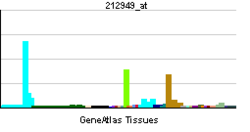- NCAPH
-
Non-SMC condensin I complex, subunit H Identifiers Symbols NCAPH; BRRN1; CAP-H; HCAP-H External IDs OMIM: 602332 MGI: 2444777 HomoloGene: 5320 GeneCards: NCAPH Gene Gene Ontology Cellular component • condensin complex
• nucleus
• chromosome
• cytoplasm
• microtubule cytoskeletonBiological process • cell cycle
• mitosis
• mitotic chromosome condensation
• cell divisionSources: Amigo / QuickGO RNA expression pattern 
More reference expression data Orthologs Species Human Mouse Entrez 23397 215387 Ensembl ENSG00000121152 ENSMUSG00000034906 UniProt Q15003 Q6ZQJ9 RefSeq (mRNA) NM_015341 NM_144818.3 RefSeq (protein) NP_056156 NP_659067.2 Location (UCSC) Chr 2:
97 – 97.04 MbChr 2:
126.93 – 126.96 MbPubMed search [1] [2] Condensin complex subunit 2 also known as chromosome-associated protein H (CAP-H) or non-SMC condensin I complex subunit H (NCAPH) is a protein that in humans is encoded by the NCAPH gene.[1][2] CAP-H is a subunit of condensin I, a large protein complex involved in chromosome condensation
Function
CAP-H is a member of the barr protein family and a regulatory subunit of the condensin complex. This complex is required for the conversion of interphase chromatin into condensed chromosomes. CAP-H is associated with mitotic chromosomes, except during the early phase of chromosome condensation. During interphase, the protein has a distinct punctate nucleolar localization.[2]
References
- ^ Cabello OA, Baldini A, Bhat M, Bellen H, Belmont JW (Feb 1998). "Localization of BRRN1, the human homologue of Drosophila barr, to 2q11.2". Genomics 46 (2): 311–3. doi:10.1006/geno.1997.5021. PMID 9417923.
- ^ a b "Entrez Gene: NCAPH non-SMC condensin I complex, subunit H". http://www.ncbi.nlm.nih.gov/sites/entrez?Db=gene&Cmd=ShowDetailView&TermToSearch=23397.
Further reading
- Nomura N, Nagase T, Miyajima N et al. (1995). "Prediction of the coding sequences of unidentified human genes. II. The coding sequences of 40 new genes (KIAA0041-KIAA0080) deduced by analysis of cDNA clones from human cell line KG-1". DNA Res. 1 (5): 223–9. doi:10.1093/dnares/1.5.223. PMID 7584044.
- Hirano T, Kobayashi R, Hirano M (1997). "Condensins, chromosome condensation protein complexes containing XCAP-C, XCAP-E and a Xenopus homolog of the Drosophila Barren protein". Cell 89 (4): 511–21. doi:10.1016/S0092-8674(00)80233-0. PMID 9160743.
- Kimura K, Cuvier O, Hirano T (2001). "Chromosome condensation by a human condensin complex in Xenopus egg extracts". J. Biol. Chem. 276 (8): 5417–20. doi:10.1074/jbc.C000873200. PMID 11136719.
- Cabello OA, Eliseeva E, He WG et al. (2002). "Cell Cycle-dependent Expression and Nucleolar Localization of hCAP-H". Mol. Biol. Cell 12 (11): 3527–37. PMC 60273. PMID 11694586. http://www.pubmedcentral.nih.gov/articlerender.fcgi?tool=pmcentrez&artid=60273.
- Strausberg RL, Feingold EA, Grouse LH et al. (2003). "Generation and initial analysis of more than 15,000 full-length human and mouse cDNA sequences". Proc. Natl. Acad. Sci. U.S.A. 99 (26): 16899–903. doi:10.1073/pnas.242603899. PMC 139241. PMID 12477932. http://www.pubmedcentral.nih.gov/articlerender.fcgi?tool=pmcentrez&artid=139241.
- Gerhard DS, Wagner L, Feingold EA et al. (2004). "The Status, Quality, and Expansion of the NIH Full-Length cDNA Project: The Mammalian Gene Collection (MGC)". Genome Res. 14 (10B): 2121–7. doi:10.1101/gr.2596504. PMC 528928. PMID 15489334. http://www.pubmedcentral.nih.gov/articlerender.fcgi?tool=pmcentrez&artid=528928.
- Heale JT, Ball AR, Schmiesing JA et al. (2006). "Condensin I interacts with the PARP-1-XRCC1 complex and functions in DNA single-strand break repair". Mol. Cell 21 (6): 837–48. doi:10.1016/j.molcel.2006.01.036. PMID 16543152.
- Nousiainen M, Silljé HH, Sauer G et al. (2006). "Phosphoproteome analysis of the human mitotic spindle". Proc. Natl. Acad. Sci. U.S.A. 103 (14): 5391–6. doi:10.1073/pnas.0507066103. PMC 1459365. PMID 16565220. http://www.pubmedcentral.nih.gov/articlerender.fcgi?tool=pmcentrez&artid=1459365.
- Beausoleil SA, Villén J, Gerber SA et al. (2006). "A probability-based approach for high-throughput protein phosphorylation analysis and site localization". Nat. Biotechnol. 24 (10): 1285–92. doi:10.1038/nbt1240. PMID 16964243.
Structures of the cell nucleus / nuclear protein Envelope (membrane)/
nuclear laminaNucleolus Other Chromatin · Dot (PML body) · Paraspeckle
SMC protein: Cohesin (SMC1A, SMC1B, SMC3) · Condensin (NCAPD2, NCAPD3, NCAPG, NCAPG2, NCAPH, NCAPH2, SMC2, SMC4) · DNA repair (SMC5, SMC6)
Transition nuclear protein: TNP1, TNP2
Nuclear matrix · Nucleoplasm · Nucleoskeleton · Nucleosol
see also transcription factors and intracellular receptorssee also nucleus diseases
B strc: edmb (perx), skel (ctrs), epit, cili, mito, nucl (chro)Categories:- Human proteins
- Chromosome 2 gene stubs
Wikimedia Foundation. 2010.
